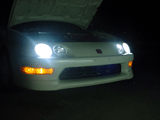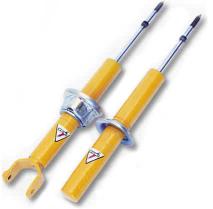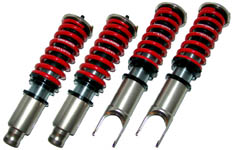
 |
One modification that's been getting a lot of attention the past few years has been HID (High Intensity Discharge) headlights. Regular headlights use a heated filament to produce light, a method called incandescence that's been used since Thomas Edison invented the first light bulb. This technology has three main problems: 1) It's highly inefficient. Only about 2% of the power used by a typical incandescent bulb produces light, while the rest is wasted as heat. 2) The filament has a very limited lifetime. And 3) the light produced has a very yellow tint, and doesn't approximate natural sunlight at all. Modern halogen lights like those used in automotive headlights improve on the basic incandescent technology somewhat by filling the glass bulb with a halogen gas rather than a vacuum or low-pressure air, and by using a higher-quality filament (usually tungsten). This improves the lifetime and light-quality problems, but not to the degree that HID lights do.
HID lights work in an altogether different manner. While their glass bulbs are also filled with a gas (usually Xenon, a noble gas), they have no filament at all. Instead, they have two electrodes, and are powered by a "ballast" which converts the car's 12V power to a high voltage level in the 10s of thousands of volts. When the high voltage is applied to the electrodes, an electric arc is created across the gap, ionizing the xenon gas into a plasma, and creating light.
Here are the advantages:
One big problem with HID retrofits has been that when people "rebase" HID bulbs so they can be installed into regular halogen headlight assemblies, the ultra-bright light is not concentrated in a useful beam pattern and ends up creating glare and bothering oncoming drivers. One good way to avoid this is to use projector assemblies specifically designed for HID bulbs. The page linked below documents one person's experience in modifying his '98 Integra headlight assemblies to use HID projectors, and looks like a great example to follow for us Integra owners. I've found kits like the one used here on Ebay.
Update: I've acquired all the parts I need: a pair of 98-01 headlight assemblies, a pair of Bosch bixenon headlight projectors, a pair of Bosch ballasts, and a pair of Philips D2S bulbs. In case you're wondering, I'm planning to upgrade to the 98-01 front bumper assembly later, so that's why I didn't use the 94-97 headlights.
The Bosch projectors have a 3-wire connection to the high-beam solenoid. I've designed a circuit to interface to this properly, and am offering this for sale to anyone interested.
If you're wondering why use bixenon projectors when our headlight assemblies already have halogen high-beams, it's because full-brightness HIDs plus high-beam halogens should add up to an extremely bright and effective high-beam system, more so than with the HIDs restricted to low-beam output. This might also be useful if you ever need to "beam" anyone...
 |
My quest for improved lighting doesn't stop with HID headlights; I also intend to install LED tail lights like many newer cars now have.
Here are some advantages:
Since no pre-made LED tail light housings are available (that I know of, and that aren't those horrible "Altezza"-style lights), I'll have to modify my existing housings to use LEDs. I'm certainly not the first to think of this; you can see another person's Integra with this modification here. This will involve obtaining some 6" oval LED lights used for truck and trailer lights, cutting the backs of my existing housings open, installing the truck lights inside, and connecting them to the car's wiring.
I've already obtained the oval truck lights for about $35 on Ebay, so hopefully it won't be too long until I can get them installed. You may have also noticed that the picture I shamelessly stole above shows an Integra with LED turn signal lights in addition to the brake lights. I don't plan to do this just yet, though I may in the future. One problem with this modification is that it may cause the turn-signal flasher to not operate correctly. In regular cars, the flasher is a very old-fashioned thermally-operated unit which assumes that high-current incandescent bulbs are being used. When one of the bulbs burns out, the flasher stops flashing, which also helps notify the driver that there's a problem. However, LED lights, due to their miniscule power requirements, appear to the flasher as a burnt-out bulb, so a different flasher is required. Luckily, universal LED-compatible flasher units are available for only $20 or so, but this is just another thing that needs to be installed, so I'll save this for later.
As I mentioned above, I plan to upgrade to the more aggressive-looking front and rear bumpers used on the 98-01 Integras. This requires new bumper covers, corner lights, and headlights, and everything bolts up with no modifications. I already have the parts for the front, though I'm still looking for a good price on the rear bumper. The only thing holding me back from installing what I have is that I haven't finished with the HID headlight project yet.
One trend that's going around a lot these days is shaved door handles. Another smaller trend is shaved door locks. The idea is mostly to make the car appear smoother by having less clutter on the outside. Today's commonplace keyless entry systems make both of these modifications possible.
I'm interested in shaving my door locks, but my primary motivation is to make theft more difficult. Integras are by far the most stolen cars in the U.S., and cars are usually stolen by thieves manipulating the lock rods inside the car doors somehow (I'll avoid going into too many specifics here so I don't help out any thieves that might be reading this). Eliminating the door locks would allow me to remove the lock rods from the door, thus eliminating one possible way of breaking into the car. To do this modification easily, I just need to get the rear door handles from the four-door Integra and install them in the front doors (this works in both the 2-door and the 4-door). The handles are the same size, and are only missing the place for the lock cylinder.
Update: I've acquired a pair of rear-door handles, but since they're a different color, I'm waiting until I upgrade my bumpers to the 98-01 style to install them, so that I can paint them all at the same time.
 |
| Koni Height-Adjustable Shocks |
 |
| Omni-Power Coilovers |
Since performance springs probably won't do that well with the worn-out stock shocks, I plan to upgrade to some performance shock absorbers eventually. The Koni "Yellow" shocks have an excellent reputation for quality and performance, have adjustable settings, and this particular model has height-adjustable spring perches just in case the springs don't sit exactly where I'd like them. Unfortunately, these shocks cost about $550 for a set, so I'm going to wait a while on them.
I also considered a full coilover setup such as the popular Tein SS coilovers, which can be bought for as low as $900, but I decided against it because the spring rates are much higher than for street lowering springs like the Eibach Pro-Kit, and I really don't want a ride that harsh. For less money, the Konis and Eibachs should give me a better ride and a sufficient range of height adjustment.
Another setup that has become popular is the Omni-power coilovers, which are relatively inexpensive at $649. However, many people have reported very dangerous problems with them where the lower mount breaks in half, causing some crashes. This part is apparently being redesigned, so if you buy these coilovers, make sure you're getting the new design.
 |
| Wilwood Big Brake Kit |
If I ever upgrade my rims to 16" rims, I hope to get some better brakes for my car. This big-brake kit from Wilwood looks really nice, and is reasonably priced at about $610 from Summit Racing. It includes drilled and slotted 12.19" rotors with black anodized aluminum hats, and Wilwood's race-proven 4-piston aluminum Dynalite calipers. Another nice feature is that the pads are easily changed simply by removing a cotter pin, without having to unbolt the caliper. These calipers use Wilwood's standardized Dynalite brake pads, which come in a large variety of friction compounds from multiple manufacturers, and are less expensive than most performance pads for Integras. Since the maximum outer diameter of this package is 13.94", they probably won't fit inside most 15" wheels (my OEM wheels taper down to only 13" inside), but 16" wheels should fit.
There is some debate about the suitability of these brakes for street use. This post on an Audi enthusiast site details how the Wilwood Dynalite calipers don't have piston dust boots like OEM brakes, and require frequent rebuilds. My inquiry to Wilwood's support department got this response however: "The dynalite calipers have been very dependable in these kits. Dust has not been an issue. On average, calipers will need to be rebuilt every 3-5 years, and kits cost about $9.00 each. Thanks for writing."
Another source for big-brake kits using Wilwood calipers (including the Superlite) is Fastbrakes.